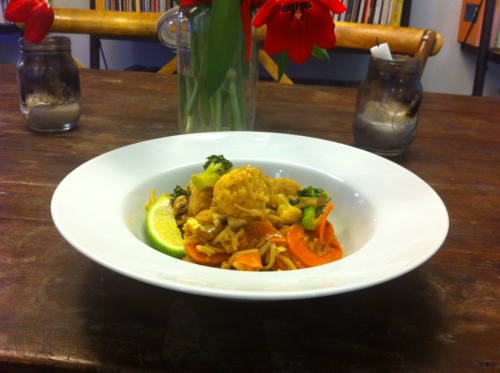Pad Thai is a controversial recipe. Traditionally, ketchup and peanut butter do not belong in Pad Thai.The slight reddish colour, instead, comes from the tamarind paste and the chili sauce. I’ve made it traditionally before, but I’ve become so accustomed to North American versions that I found something was lacking. If you’re a stickler for tradition and aren’t a vegetarian, you can omit the ketchup and peanut butter and sub in fish sauce in place of ½ the soy sauce. Feel free to serve it on top with chopped cilantro, as well, if desired. This version is a slight tweaking of a traditional recipe and will taste like the yummiest takeout from your local Thai hole-in-the-wall. I saw Mike get up about 5 times after dinner to sneak more, so I guess it was an unqualified success.
This is a marriage of traditional Pad Thai and Americanized Pad Thai.Usually, vegetables are not a big part of Pad Thai, but adding them in really turns it into a meal by itself and adds to the nutritional content. Feel free to substitute any vegetables that are hanging on for dear life in your produce drawer, that’s what we did, just make sure to add them in order of how fast they cook. White wine or a light beer (such as a pilsner or a light Asian beer) really pairs nicely here.
Ingredients: 1 package rice noodles 4 green onions 1 white or yellow onion 4 cloves garlic minced 1.5 tablespoons grated or minced galangal or ginger 3 cups bean sprouts 1 cup dry roasted peanuts, ground or chopped (I used a mortar and pestle) 1 cup sliced broccoli 1 cup sliced carrots 1 cup sliced cauliflower 10 mushrooms, sliced thinly ½ cup vegetable broth 1 package extra firm tofu, cubed 2 tablespoons oil Lime wedges for serving, optional Pad Thai sauce: 3 Tbsp. tamarind paste, to taste (available at Asian/East Indian food stores) 1/2 cup vegetable stock 7 Tbsp. soy sauce or tamari sauce (tamari is gluten free) ½ Tbsp. Siracha chilli sauce (1 Tbsp. would make it spicy, if desired) ½ cup. brown sugar, or more to taste 6 Tbsp. ketchup 4 Tbsp. peanut butter A sprinkle of salt and pepper Directions: 1) Heat up pot of water to boil and turn off heat. Add rice noodles, soak for 4-6 minutes, until limp but still undercooked. Drain and rinse with cold water. Set aside. 2) Add all sauce ingredients to sauce pan, heat up to boiling and reduce heat to simmer for 10 minutes. Whisk all ingredients together while simmering. Set aside. 3) Heat up wok or large frying pan to medium heat. Add oil and the white or yellow onion. After a few minutes, add garlic and galangal/ginger. Add in ¼ cup vegetable stock and carrots and cauliflower. 4) After about 8 minutes, add broccoli, tofu, and mushrooms. Cook for another 8 minutes or so. 5) Add noodles and ¼ cup vegetable broth. Toss everything together using tongs and a spatiula. Add in pad thai sauce and stirfry everything together. Cook for 5 minutes, make sure to keep stirring to keep anything from burning. 6) Turn off heat, fold in bean sprouts. Serve with green onions and ground peanuts sprinkled on top and a lime wedge on the side.


